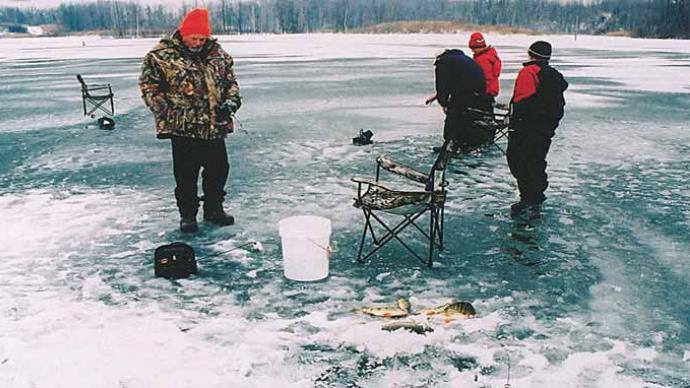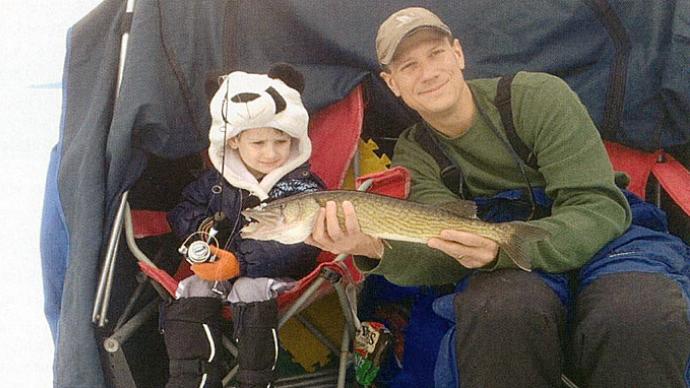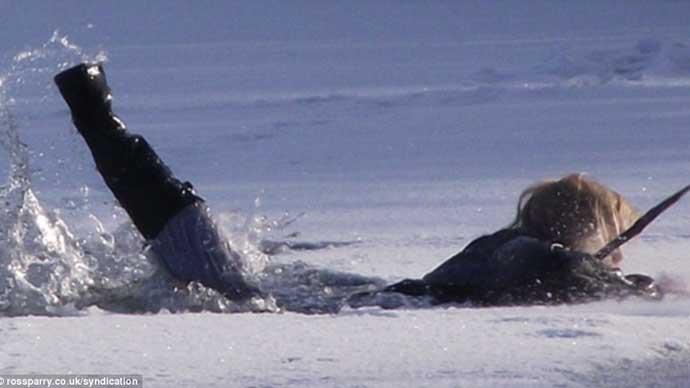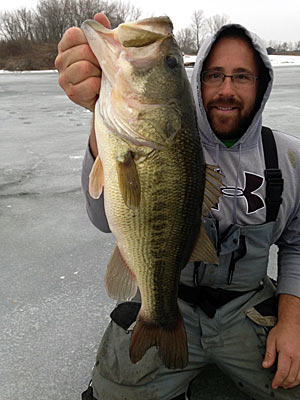
Like most Minnesota anglers, Scott Mackenthun spends his winters ice fishing. He often chases panfish, which are as enjoyable to catch as they are on the table. He’ll set up just outside a bed of aquatic vegetation, using small jigs and spoons to call them in. But they aren’t all that shows up.
It’s not uncommon for Mackenthun, whose day job is the state Department of Natural Resources’ Hutchinson area fisheries supervisor, to see a significant mark move across his fish finder’s screen and catch it. Sometimes it’s a northern pike. But with some regularity, it’s a big largemouth bass.
The situation isn’t much different about 150 miles south of Mackenthun on Iowa’s Great Lakes. They include the state’s largest natural lake, 5,684-acre Big Spirit, whose banks are where fishing industry stalwart Berkley continues to manufacture tackle, and five more interconnected ones, including East and West Okoboji. Shane Akin helps his Great Lakes Guide Service clients catch panfish, perch, walleye, and northern pike on them during the hard water season. “When we’re pan fishing, people will pick up three or four bass during a day,” he said. “[Bass are] more fun to catch than the little bluegills.”
For most ice anglers, catching a bass is a bonus. But they become more than an occasional happy accident with determination and know-how. Mackenthun believes they are patternable, and Akin has put that into practice, catching bass between 2 1/2 and 3 pounds — with the possibility of a 5-pounder — through the ice. Add in opportunities, such as bass seasons that go year-round in Iowa and close in February in Minnesota, and hibernation is no longer the only wintertime option for bass anglers whose local lakes lock up with ice.
Ice bass biology
Growing up in Connecticut, Eric Altena fished for bass through the ice. He continues to do it in Minnesota, where he’s the Department of Natural Resource’s Little Falls area fisheries supervisor. “Smallmouth bass generally have been thought of as ‘shutting down’ during winter months, yet there are fisheries [such as] Chequamegon Bay area [of Lake Superior] where you can actively target them through the ice and be successful,” he said. It’s tougher sledding on the Mississippi River, where he said finding a smallmouth bite through the ice is almost impossible. In his work — electrofishing or netting — smallmouth are rarely captured in water 39 degrees or colder.
Largemouth are different, Altena said. “We see them move as soon as the ice starts coming off lakes in our trap nets, and anglers routinely catch them through the ice in the spring while fishing panfish,” he said. Akin’s experience supports that. He mostly catches largemouth, which he finds over soft bottoms, sharing the last green strands of aquatic vegetation with panfish. He picks up an occasional smallmouth near rock humps and points while fishing for walleye.
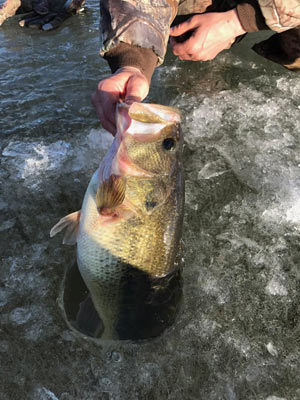
Cold-blooded bass have slower metabolisms in winter, so smaller meals and narrower feeding windows are the norms. “The fish have to eat in summer more than in winter, and that can create a challenge [for anglers],” said Nate Herman, whose Illinois-based family business builds and manages private lakes across the Midwest. He even teaches their owners how to catch the trophy bass that swim in them, regardless of the season. “There’s no point in having a bunch of big bass if you’re not going to fish for them,” he said. A day on the ice can include a dozen or more bass between 3 and 7 pounds. “It can be just as good as a day on open water, spring, summer, or fall,” he said. “It can be a lot of fun.”
Grab your gear
Ice fishing, like most angling approaches, can be done with a little or a lot of gear. While portable shelters, fish finders, sleds, ATVs or snowmobiles, and power augers are used by many, other ice anglers grab only the bare necessities: a few lures, a rod, and a long metal bar — spud — to knock holes in the ice. Much of the gear used for fish traditionally caught when ice fishing can double for bass. Akin, for example, uses the same Eyeconic ice rods, outfitted with small reels and light line, for bass that he uses for walleye.
Akin’s lure choices are familiar to most ice anglers. He softly shakes small tungsten jigs like a Kenders Outdoors 4mm model, tipped with live bait or a 2-inch soft-plastic lure. He also likes to jig a small spoon slowly. He said smaller lures with less action produce bigger fish and more bites. “It’s opposite of what you’d think,” he said.
Herman packs the same types of lures as Akin. He also deploys live bait on tip-ups, allowing him to fish more holes simultaneously. He keeps these offerings suspended off the bottom. “A large bass will move up in the water column to eat it,” he said. But in the end, what he puts on the end of his line isn’t his most important decision. “For me, it’s more location, and are the fish active,” he said.
Pick your places
Ice fishing isn’t a slow process for Herman. He starts by drilling between 50 and 100 holes in the ice, each purposely placed to help him cover from 4 to 15 feet of water. He hops hole to hole, spending no more than about 2 minutes at each without a bite. He’ll stay at a hole longer if the catching is hot, having a different lure rigged and ready to rekindle a cooling bite. And once he finds the most productive depth, he’ll stick to the holes over it. He said it’s not much different than running and gunning in open water.

Herman said changing conditions affect bass the same in winter as they do in other seasons. His best bites, for example, often happen early or late in the day. Akin’s better bites often come after a few consecutive sunny days, especially when the ice is snow-free. That allows the sun to shine into the water, warming it a few degrees. Runoff flowing under the ice, which most often happens later in the season, can have a similar effect on the fishing, Akin said.
Bass rely on structure and cover under the ice, too. If Herman is familiar with the lake that he is ice fishing, he’ll place his holes over key structure such as points, ledges, and pinch points along creek channels. He allows shallow-water holes to “rest” after drilling, giving nearby bass time to recover from the commotion caused by his power auger.
Like most ice anglers, Herman uses a fish finder to watch his lure and the fish. But one isn’t always necessary, especially in shallow clear water. “Many times, I have my face to the hole, looking around to see what’s down there,” he said. That includes brush piles and fish swimming around them. Even over deeper water, where you need to rely on electronics, he said you can learn more about a spot by standing stationary over it than bobbing in a boat.
Akin searches out submerged aquatic vegetation, the same mix of coontail and cabbage that attracts largemouth in open water. But instead of keying on the outside edges in 22 to 26 feet of water, as he does during summer, he heads shallower. In the fall, as deeper vegetation dies, bass move to the 11- to 15-foot zone, where they’ll stay all winter. “That’s where we find the majority of bass,” he said.
It’s essential to fish still green aquatic vegetation, which produces oxygen. Dead brown vegetation has the opposite effect, pulling oxygen from the water as it decomposes. Its presence leaves you one option. “You need to move,” Akin said. “You’re not going to catch much there.”
Green aquatic vegetation has one more byproduct — fishing pressure. Akin said ice anglers on West Okoboji Lake, for example, flock to about six main ice-fishing spots, each having the best vegetation. He pays attention to the locations of individual anglers, setting up slightly away from them in an attempt to find less pressured fish.
Watch your step
Safety should always be a priority whenever and wherever you fish, but it’s vital while ice fishing when cold-water survival is measured in minutes. Weather and water conditions can create ice that looks stable but isn’t. Take your time, and check the ice’s stability along the way with a spud, especially early and late in the season. Some other safety tips, courtesy of South Dakota Game, Fish, and Parks.
- Thicker ice supports more weight. One angler will need 4 to 6 inches of new clear ice, and a snowmobile or ATV will need 6 to 12 inches. Wait until there is at least 16 inches before crossing in a vehicle. Ice weakens as it ages and never refreezes to its original strength.
- Wear ice picks around your neck, which can be used to claw your way out of the water if you break through the ice. The best safety device is a buddy; avoid ice fishing alone.
- Flowing water, springs, and heaves make ice dangerous. These spots can be challenging to see in the dark, so keep your ice fishing to daylight hours. Local bait shops can offer advice on avoiding these places on the lakes you plan to fish.
- Be aware of changing ice conditions. Do not assume that because one area is safe, the rest of the water body is as well.
While your safety comes first, you must also consider the bass, especially if you plan to release them. “It’s much easy on a bigger fish than in warmer water,” Herman said. A slower metabolism means they won’t wear themselves out fighting. He said cold water holds more dissolved oxygen, and bacteria, such as those that cause infections where slime coat is removed, aren’t as active. Limit the time a bass spends out of the water when air temperatures are below freezing. He said if it’s too cold, their fins can quickly freeze. But even with these easily mitigated safety concerns, Herman said ice fishing has plenty of upsides. It’s a great way to enjoy time outside with friends. “And you can catch a few fish,” Herman said. “That’s a bonus.”


